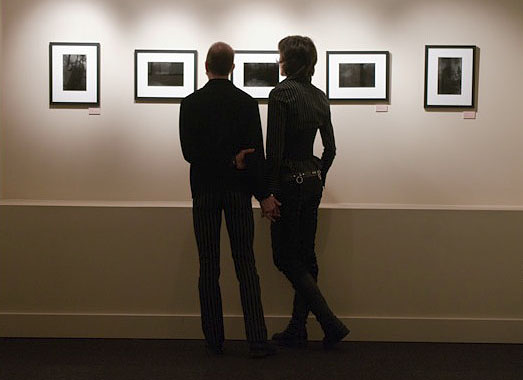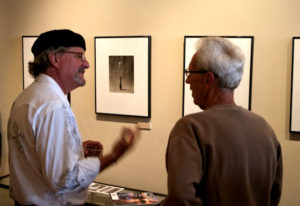Exhibit Your Photos for Prestige and Profit
By Peter E. Randall–

Photo courtesy of Lightbox Photographic Gallery.
For most photographers, the chance to have a one-person exhibit is an exciting opportunity. Then reality sets in and it’s apparent that having an exhibit is more stressful and difficult than making the photographs in the first place.
The most ideal opportunity is to be invited to show by a major gallery or a museum, but for most of us that’s not an option. We don’t have the reputation or the following sought by larger venues. Coffee shops, restaurants, banks, and hospitals often welcome artists to show their work. Usually you’ll have to approach them, showing actual prints or images on a tablet. Smaller galleries and art associations offer another alternative. The New Hampshire Art Association, for example, has a large gallery for monthly, juried group shows, but a smaller gallery can be rented by the artist/photographer.

Prints can be displayed framed or unframed. To avoid reflections, some photographers prefer not to use glass or acrylic.
Wherever you show, it’s essential to present a professional image. Select a theme for your show, not just “my favorite images.” Local scenes, landscapes, portraits, flowers, birds or a specific place are a few ideas. You could shoot for a show, concentrating on a specific theme until there is enough work to make a selection to exhibit. Be ruthless when editing, eliminating un-sharp images and others that you may like but that don’t fit with the rest of your images. Ask a photographer or artist friend or two to go over your work help with the selection.
When you have a venue, talk with the people there about the number of images to hang and potential print sizes. Probably 8 x 10s are too small, but 11 x 14 or 16 x 20 might be just right. Larger prints might work in some venues, but not in others. Typically all prints should be the same size, or at least have a common width or height depending on the shape of the photograph. Some subjects might benefit by being larger or smaller, but avoid a wide number of sizes. A mix of horizontal and vertical images adds interest.
Make prints with borders, two inches on each side, so they can be matted without losing part of the image. I use lots of Red River Paper’s Aurora White that works equally well for color and black and white images. I prefer matte finish and I like the paper’s thickness.
Work should be properly framed and matted. Frame shops know how to do this but they could be expensive. I use American Frame which sells frames with custom mattes that you can assemble yourself. It’s not difficult, looks professional, and saves money.

With proper promotion, you can draw a large crowd. Photo courtesy of Lightbox Photographic Gallery.
Exhibits typically run about a month and your dates may be six months to a year in the future. This allows time to add images for potential use in the exhibit and, of course, to do the framing. This lead-time also gives an opportunity to plan your publicity. Social networking, such as Twitter or Facebook, can be used to spread the word and local newspapers are always looking for stories. You will want to coordinate with the folks at your venue as they probably have publicity contacts and promotional ideas.
You should also be thinking about why you want to do an exhibit. Do you just want to share your work others? This may be the best reason for your exhibit. Posting your images on social media provides some satisfaction, but having people see your images large and hanging on a wall is a different experience.
Do you plan to use the exhibit to promote your work in hopes of getting commercial work? Assuming you want to photograph professionally, your exhibit might get the attention of media buyers for ad agencies or from corporate executives who want images for their offices.

An exhibit can offer you a chance to meet people, gain feedback and sell your work. Photo courtesy of Lightbox Photographic Gallery.
Do you want to make money with an exhibit? Non-gallery venues probably will not charge a sales fee; they are mostly interested in having work on their walls to entertain their customers. Pricing your work reasonably will generate some sales. Brooks Jensen, editor of Lenswork suggests lower prices to get more sales and to have your work hanging in homes and offices, rather than stacked in your back room.
I have conducted a workshop at a large non-profit conference center. At the end of the week we had an exhibit of unframed prints that we sold for $10 each, and we donated the money to the conference center. Attendees at other conferences being held at the same time bought 50-60 images and for most of my workshop participants this was the first time they had sold work. They were thrilled to have someone care enough about their photographs to buy them.
Galleries, however, are in business to sell art and usually will charge a fee of 40 percent of each sale. The gallery may have pricing suggestions. A few years ago I had a retrospective with 70 images and I sold 13 at $300 each at the opening. After the sales commission I earned only about half of what it cost to print and frame all 70 photographs. Nevertheless, I was pleased that many of my friends cared enough about my work to want to hang it in their homes or offices.
The bottom line: have fun with your exhibit, hope to sell a few prints, but don’t worry about making a profit.
About the Author
Pete Randall is a Red River Pro who has authored fourteen books, nine of which feature his photographs. He works mostly in New Hampshire and Maine but has also done assignments all over the world. His images have been published in national magazines, and his work has been widely exhibited.
Click here to visit his website.
Original Publication Date: June 02, 2017
Article Last updated: June 02, 2017
Related Posts and Information
Categories
About Photographers
Announcements
Back to Basics
Books and Videos
Cards and Calendars
Commentary
Contests
Displaying Images
Editing for Print
Events
Favorite Photo Locations
Featured Software
Free Stuff
Handy Hardware
How-To-Do-It
Imaging
Inks and Papers
Marketing Images
Monitors
Odds and Ends
Photo Gear and Services
Photo History
Photography
Printer Reviews
Printing
Printing Project Ideas
Red River Paper
Red River Paper Pro
RRP Products
Scanners and Scanning
Success on Paper
Techniques
Techniques
Tips and Tricks
Webinars
Words from the Web
Workshops and Exhibits
all
Archives
January, 2025
December, 2024
November, 2024
October, 2024
September, 2024
August, 2024
July, 2024
June, 2024
May, 2024
more archive dates
archive article list




